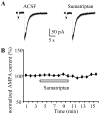Presynaptic 5-HT(1B) receptor-mediated serotonergic inhibition of glutamate transmission in the bed nucleus of the stria terminalis
- PMID: 19963045
- PMCID: PMC2815192
- DOI: 10.1016/j.neuroscience.2009.11.071
Presynaptic 5-HT(1B) receptor-mediated serotonergic inhibition of glutamate transmission in the bed nucleus of the stria terminalis
Abstract
Activation of neurons in the bed nucleus of the stria terminalis (BNST) plays a critical role in stress and anxiety-related behaviors. Previously, we have shown that serotonin (5-HT) can directly modulate BNST neuronal excitability by an action at postsynaptic receptors. In this study we built upon that work to examine the effects of 5-HT on excitatory neurotransmission in an in vitro rat BNST slice preparation. Bath application of 5-HT reversibly reduced the amplitude of evoked excitatory postsynaptic currents (eEPSCs). These effects were mimicked by the 5-HT(1B/D) receptor agonist, sumatriptan, and by the 5-HT(1B) receptor selective agonist, CP93129. Conversely, the effects of 5-HT and sumatriptan could be blocked by the 5-HT(1B) receptor-selective antagonist, GR55562. In contrast, the 5-HT(1A) receptor agonist 8-OH DPAT or antagonist WAY 100635 could not mimic or block the effect of 5-HT on eEPSCs. Together, these data suggest that the 5-HT-induced attenuation of eEPSCs was mediated by 5-HT(1B) receptor activation. Moreover, sumatriptan had no effect on the amplitude of the postsynaptic current elicited by pressure applied AMPA, suggesting a possible presynaptic locus for the 5-HT(1B) receptor. Furthermore, 5-HT, sumatriptan and CP93129 all increased the paired pulse ratio of eEPSCs while they concomitantly decreased the amplitude of eEPSCs, suggesting that these agonists act to reduce glutamate release probability at presynaptic locus. Consistent with this observation, sumatriptan decreased the frequency of miniature EPSCs, but had no effect on their amplitude. Taken together, these results suggest that 5-HT suppresses glutamatergic neurotransmission in the BNST by activating presynaptic 5-HT(1B) receptors to decrease glutamate release from presynaptic terminals. This study illustrates a new pathway by which the activity of BNST neurons can be indirectly modulated by 5-HT, and suggests a potential new target for the development of novel treatments for depression and anxiety disorders.
Figures







References
-
- Aston-Jones G, Harris GC. Brain substrates for increased drug seeking during protracted withdrawal. Neuropharmacology. 2004;47 (Suppl 1):167–179. - PubMed
-
- Berk ML. Projections of the lateral hypothalamus and bed nucleus of the stria terminalis to the dorsal vagal complex in the pigeon. J Comp Neurol. 1987;260:140–156. - PubMed
-
- Bonaventure P, Schotte A, Cras P, Leysen JE. Autoradiographic mapping of 5-HT1B- and 5-HT1D receptors in human brain using [3H]alniditan, a new radioligand. Receptors Channels. 1997;5:225–230. - PubMed
-
- Boschert U, Amara DA, Segu L, Hen R. The mouse 5-hydroxytryptamine1B receptor is localized predominantly on axon terminals. Neuroscience. 1994;58:167–182. - PubMed
Publication types
MeSH terms
Substances
Grants and funding
LinkOut - more resources
Full Text Sources

